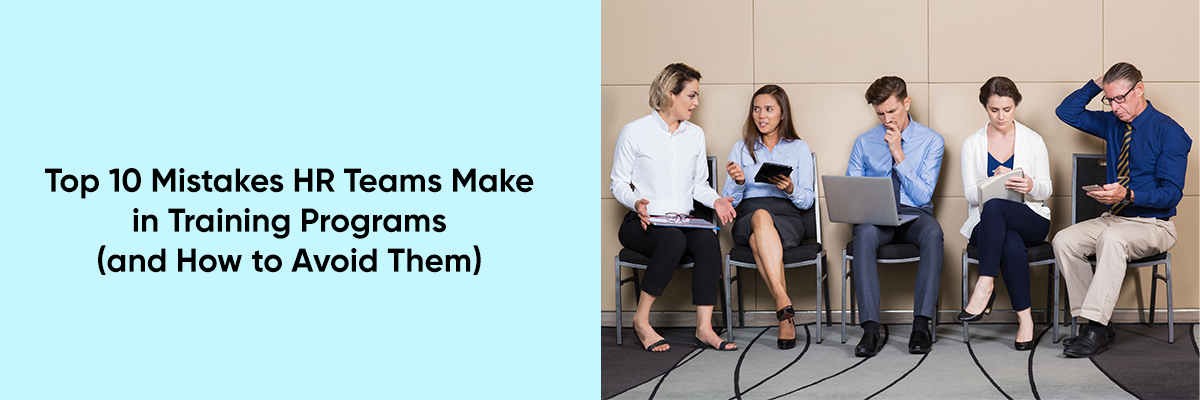Training is crucial for any organization, as it equips employees with the skills and knowledge necessary to adapt to constantly changing environments. In today’s fast-paced world, where customer behavior, business dynamics, technology, and regulations are continually evolving, the importance for employee training is increasing.
For example, customers now conduct online research before making purchasing decisions, a shift in behavior influenced by technological advancements like AI, which have disrupted traditional business models. To remain competitive, companies must ensure that their employees—both new and existing—are equipped with the latest skills and tools to navigate these changes effectively.
Training, therefore, is not a one-time event but a continuous process that empowers employees to work efficiently and drive the company forward. However, despite the clear importance of training, many organizations make critical mistakes in their training programs, leading to ineffective results that fail to prepare employees for both current challenges and future growth.



If you want to stay updated on Human Resource topics, learn from industry experts, and keep your HR knowledge current, visit our HR webinar page. Here, you’ll find both on-demand and upcoming webinars that cover HR best practices, compliance, and more. These sessions, led by experts, not only help boost your career but also provide HRCI and SHRM credits to keep you professional-ready.
Now, let’s dive into the 10 common mistakes made by HR teams or companies.
- Lack of Clear Objectives
When you approach something without clear objectives, it lacks purpose. The same applies to training programs. If a training program is created without specific objectives, it wastes not only the employees’ time but also the company’s resources. A program without clear goals yields no results because the trainers haven’t defined the desired outcomes. It’s like shooting an arrow without a target—without aim, you can’t expect to hit the mark. Similarly, when designing training programs for employees, always establish clear objectives. For instance, if you’re teaching time management, the objective should be improved efficiency—ensuring tasks are completed on time, without overtime or last-minute work. In short, every training program should be crafted with clear goals in mind, with all elements aligned to help employees achieve them. Never make the mistake of creating a training program without defined objectives.
- Failure to Assess Current Skill & knowledge Level
One of the biggest mistakes in training is providing the same program to all employees without first assessing their individual knowledge and skill levels. Every employee has unique experience, strengths, and areas for improvement. Offering training without understanding where they stand in terms of skills and knowledge leads to wasted time, money, and resources. For example, employees who are already proficient in certain areas may find the training redundant and disengaging, while others who lack foundational skills may struggle to keep up. This approach results in ineffective training that fails to address the real needs of your employees. To avoid this, companies should assess employees’ skills through performance evaluations or simple tests before assigning training. With this insight, you can tailor the training program or create multiple programs to focus on areas that require improvement, making the training more relevant, efficient, and impactful for each individual.
- Relying on a One-Size-Fits-All Training Program
The “One-Size-Fits-All” Training Program is one of the most common mistakes in office training. As mentioned earlier, not all employees have the same knowledge, skills, or learning styles. Some are more visual learners who prefer to watch demonstrations, while others learn better through theory or hands-on experience. Some may pick up concepts quickly, while others need more time. Some employees feel comfortable asking questions when they’re confused, while others may hesitate to speak up. Some need more individual attention from the trainer, while others require little guidance. When you fail to account for these differences, your training program becomes less effective, and employees may not absorb the material as intended.
The key is not to create rigid, one-size-fits-all training but to design a flexible program that adapts to the needs of diverse learners. By tailoring the program to accommodate different learning styles and paces, you can ensure that all employees benefit from the training, leading to better results for the company. When done correctly, this approach helps meet the individual needs of employees while achieving the desired training outcomes.
- Not Involving Experts and Top Management in Training
Training can be conducted by anyone who has knowledge of the concepts or skills that a company wants to impart to its employees. However, if the training is delivered by just any employee, there is a risk it may not achieve the desired outcomes.
This is why it’s essential for all training programs to involve experts who not only possess years of experience in the subject matter but also have a strong background in effective teaching methods. These experts can come from senior management roles, such as HR managers or employers, or they can be professional trainers with a proven track record of successful employee development.
To ensure a continuous cycle of skilled trainers, assistant trainers should be paired with these experts to learn the ropes and gain valuable experience. This approach not only enhances the quality of training but also builds a foundation for future trainers, ensuring that the company’s training goals are met consistently and effectively.
- Not Investing Enough in Training Time, Tools and Resources
Investing the right amount of time and resources is crucial for successful training. When training sessions are too short—lasting only a few days, for example—they often fail to meet their objectives and end up being ineffective. Moreover, not investing in the necessary tools and resources can make the training experience even worse. The time required, the tools needed, and the resources to be allocated should all be carefully determined during the training development phase. This is the stage where you assess the specific training goals and plan accordingly, identifying the right amount of time and the appropriate resources to support those objectives. By thoroughly planning these aspects in advance, you can ensure that the training is well-structured, uses the right tools, and delivers meaningful, impactful results that truly achieve the desired outcomes.
- Overloading Trainees with Information
One common mistake in training programs is overwhelming employees with too much information. For experts providing the training, the knowledge and skills being taught may seem basic and straightforward. However, for employees who are less familiar with the material, the information can feel new, complex, and difficult to process. This is why it’s crucial to present training content in a systematic way.
Training is a dynamic process that unfolds over time, and it’s not something that can be crammed into just a few days. Overloading employees not only makes the current training session less effective, but it also impacts their ability to understand subsequent training sessions, as they struggle to grasp foundational concepts.
To avoid this, trainers should adapt their approach based on the different learning styles and needs of the participants, ensuring that the training process is paced correctly and allows learners to absorb information without becoming overwhelmed.
- Not Understanding the Correct Timing for Training Needs
One of the most common mistakes organizations make is failing to identify the right time to implement training. Often, HR departments schedule training too late, meaning by the time employees receive the necessary skills, competitors are already ahead, with their workforce equipped with up-to-date knowledge and tools.
In today’s fast-paced business environment, where technology and industry standards are constantly evolving, delayed training can leave employees with outdated skills, hindering their ability to keep up. To avoid this, it’s essential to assess training needs early on and schedule learning opportunities proactively.
Regularly updating and aligning training with the company’s strategic goals ensures that employees are always equipped with the most current skills, allowing the company to stay competitive and adaptable in a rapidly changing market.
- Neglecting to Evaluate Program Effectiveness
One common mistake many organizations make is neglecting to evaluate the effectiveness of their training programs. After the training is completed, it’s easy to move on and assume that the objectives were met, but without proper evaluation, there’s no way to know if the training actually delivered the intended results.
Failing to assess the impact of training can lead to repeating the same mistakes, with programs that don’t address the real needs of employees or the business. It’s crucial to gather feedback, measure performance improvements, and evaluate whether the goals were achieved. By regularly assessing the effectiveness of training programs, organizations can ensure continuous improvement and make adjustments to better meet the evolving needs of both employees and the company.
- Ignoring Trainee Feedback
Another mistake often overlooked is ignoring the feedback from trainees themselves. When employees complete a training program, they are the best source of insight regarding what worked and what didn’t. However, many organizations fail to collect or act on this valuable input. Without trainee feedback, it’s difficult to gauge the true effectiveness of the training experience and identify areas for improvement. Listening to employees helps refine future training efforts and ensures that programs are engaging, relevant, and impactful. Regularly gathering and acting on feedback ensures that training programs evolve to meet the needs of the workforce, leading to better learning outcomes and more engaged employees.
- Failure to Provide Ongoing Support After Training
Providing training is just the beginning—many organizations make the mistake of assuming that once the training is over, employees will immediately apply what they’ve learned. In reality, without ongoing support, employees often struggle to retain and implement new skills.
Training should be seen as an ongoing process, not a one-time event. Failing to provide continued support, whether through follow-up sessions, coaching, or access to resources, can result in the training’s impact fading quickly. It’s essential to create an environment where employees feel supported and have the tools and guidance to apply their new skills effectively. Offering continuous support ensures that the training remains relevant and employees can continue to grow and develop in their roles.
Conclusion
Training is a powerful tool for growth, but only when it’s done right. By avoiding these common mistakes—such as neglecting to evaluate effectiveness, failing to consider timing, or ignoring trainee feedback—organizations can ensure their training programs are impactful, relevant, and aligned with business goals.
Continuous improvement and strategic planning in training are key to keeping employees equipped with the skills needed to thrive in an ever-evolving business landscape. By investing in well-planned, tailored training programs, organizations can build a workforce that is not only prepared for today’s challenges but also ready for tomorrow’s opportunities.


